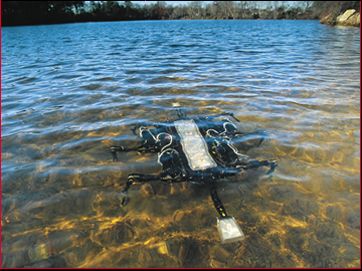


Bi-o-mi-met-ics, n., the use of living creatures as inspiration
for machines [hist., 1995, Amer.]
Just below the surface of a reservoir outside Boston, robot Ariel walks sideways like the crab it is patterned on. A machine with a serious purpose, it is designed to scuttle from the shore through the surf to search for mines on the ocean floor. Ariel was funded by the Defense Advanced research Projects Agency and built by iRobot, a company founded by MIT robot guru Rodney Brooks. Inspired by research on crabs at Robert Full's lab at Berkeley, Ariel takes advantage of the animal's stability - and improves on it. Unlike real crabs, which must struggle to right themselves if a wave flips them on their backs, the robot simply reorients itself and keeps walking with its body upside down. But despite its abilities, the technician in charge of the machine, Ed Williams, supervises Ariel's excursions with great anxiety - the machine still gets stuck when it encounters big rocks. "Robots can't do much now," he says, philosophically, "but airplanes couldn't do much in 1910.
Origin
of Name
Main character in the movie The Little Mermaid
Purpose
To find mines
Creative
Inspiration
Biological inspiration from crabs. Engineering inspiration
from limitations of previous robots.
Height
9 cm, stands 15 cm
Length
55 cm (main body); 115 cm (including outrigger arms
for compass and inclinometers)
Weight
11 kg
Vision
None
Sensors
Motor position, foot contact, pressure (underwater),
flow (underwater), compass, inclinometer, metal detectors
Frame
Composition
Anodized aluminum
Batteries
22 NiCd cells
External
Power
Optional (while recharging batteries)
KLOC
6
Cost
$50,000 (materials only)
Project Status
Ongoing
Information Source
John Aspinall


